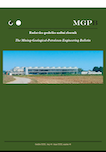The Study of the Reservoir Inter-architecture Structure and Remaining Oil in the Eastern Part of Sabei Ⅱ District
DOI:
https://doi.org/10.17794/rgn.2019.3.2Keywords:
reservoir structure, point bar, channels, sandstone reservoir, Putaohua reservoir, DaqingAbstract
In the Daqing oilfield,HeilongjiangProvince, China,in the eastern part of the Sabei Ⅱ District is a fine potential-tapping demonstration area with a long development time and complex history of well conditions. As oil exploration has entered into the high-water cut stage, the fine description of reservoir structure hada great significance to improve the effect of oil exploration. An abandoned channel is an important basis for recognizing a single river border and point bar. The top sand-shale interbedded or muddy sediments have a shelter action for the reservoir fluid, so correctly recognizing the abandoned channel is an important scientific basis for further analysing reservoir architecture and exploring the remaining oil. Due to the lateral shelter action of sand-shale interbedded with muddy sediments, the semi-connected body, consisting of abandoned and normal channel sand body, leads to an injection and production imbalance, which is namely production without injection or injection without production. It makes the top of the channel sand body become the favourable gathering place for remaining oil and a further main exploring object.
Downloads
Published
How to Cite
Issue
Section
License
Copyright (c) 2019 authors and journal

This work is licensed under a Creative Commons Attribution 4.0 International License.
Creative Commons-BY
Authors who publish with this journal agree to the following terms:
In agreeing this form, you certify that:
- You read the ethical codex of the RGN zbornik available at journal web.
- You submitted work is your original work, and has not previously been published and does not include any form of plagiarism.
- You own copyright in the submitted work, and are therefore permitted to assign the licence to publish to RGN zbornik.
- Your submitted work contains no violation of any existing copyright or other third party right or any material of an obscene, libellous or otherwise unlawful nature.
- You have obtained permission for and acknowledged the source of any illustrations, diagrams or other material included in the work of which you are not the copyright owner.
- You have taken due care to ensure the accuracy of the work, and that, to the best of your knowledge, there are no false statements made within it.
- All co-authors of this submitted work are aware of, and in agreement with, the terms of this licence and that the submitted manuscript has been approved by these authors.
Publication licence
You retain copyright in your submitted work, according to journal license policy (CC-BY). By signing this form you agree that RGN zbornik may publish it under the publication licence. In summary the licence allows the following:
Anyone is free:
- To copy, distribute, display, and perform the work.
- To make derivative works.
Under the following conditions:
- The original author must always be given credit.
- The work may not be used for commercial purposes.
- If the work is altered, transformed, or built upon, the resulting work may only be distributed under a licence identical to this one.
Exceptions to the licence
In addition to publishing the work printed under the above licence, RGN zbornik will also enable the work to be visible online.
The journal editorial can change the licence rules anytime but it cannot retroactively restrict author(s) rights.


